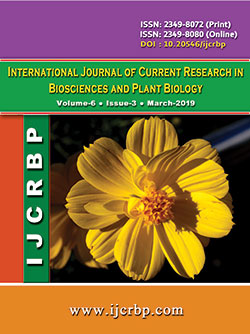 |
Online ISSN : 2349-8080 Issues : 12 per year Publisher : Excellent Publishers Email : editorinchiefijcrbp@gmail.com |
Twenty eight female Zaraibi goats in 2nd, 3rd and 4th season of lactation with average body weight of 33.0 kg were divided randomly into 4 groups (7 does in each) to study the effect of substitution of berseem forage by triticale forage in diets of lactating Zaraibi goats on their performances for milk yield and composition. In addition, twelve Rahmani rams average body weight of 50 kg were used to evaluate the feeding value of tested diets. Half the crude protein (CP) requirements of lactating goats were covered from concentrate feed mixture (CFM) while other 50% of CP was covered from triticale forage in the first group (G1), mixture forage (50% triticale- 50% berseem) in the second group (G2), mixture forage (70% triticale- 30% berseem) in the third group (G3), and berseem forage in (G4). The obtained results showed that the dry matter (DM) percent of triticale was higher than berseem (16.50 vs. 13.98). Moreover, the ether extract (EE) and nitrogen free extract (NFE) were higher while CP and ash were lower in triticale forage than berseem. But, crude fiber (CF) was nearly similar in both forages. The daily dray mater intake (DMI) as g/ kg w0.75 and body weight (BW) tended to increase with mixture forage G2 (99.10 and 4.07, respectively) compared with G3(98.75 and 4.06, respectively) and G4 (95.27 and 3.91, respectively) and G1 (91.79 and 3.77, respectively). Ammonia-N (NH3-N) level and pH values tended to decrease in the rumen of Rahmani sheep fed triticale forage (G1) compared with other forages (G2, G3, and G4). Rumen volatile fatty acids (TVFA's) concentrations as well as microbial protein (MP) were higher with 50% triticale - 50% berseem than with other rations. The digestion coefficients of OM, CF and NFE were significantly improved with G2 and G3 compared with G1 and G4. The CP, DM and OM digestibility recorded the lowest values (P<0.05) with triticale forage. The total digestible nutrients (TDN) showed the higher estimates (P<0.05) with the mixture rations (G2 and G3), while digestible crude protein (DCP) was significantly higher with increasing berseem in the rations. Whereas, serum protein, albumin, globulin, urea-N and glucose did not significantly differed among the tested diets. Concerning milk production, the obtained data indicated that milk yield of Zaraibi goats was significantly (P<0.05) higher with mixture forage (1.350 kg/ h/ d) G2 and (1.310 kg/h/d) G3 compared with the other groups (1.230 and 1.260 for G1 and G4, respectively). The effect of experimental treatments on milk fat percentage was significant (P<0.05). While, other milk contain and milk quality parameters (such as pH value and acidity %) were not significant. Accordingly, it could be concluded that using mixture forage (triticale and berseem) in feeding Zaraibi goats has positive effect on feeding value, milk yield and milk composition as well as feed utilization efficiency. Triticale forage could be safety use in feeding Zaraibi goats as it is or mixed with berseem.
